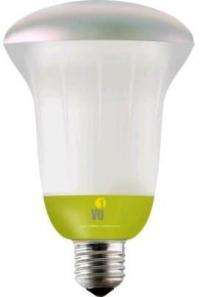Vu1's conceptual design for its R-30 bulb. Credit: Vu1.
(PhysOrg.com) -- While compact fluorescent lights (CFLs) are currently the primary alternative to incandescent light bulbs, a company from Seattle predicts that its own novel light bulbs will eventually replace CFLs and LEDs. Vu1 ("view one") Corporation has been working on its electron stimulated luminescence (ESL) bulbs, and has recently released a demo video (below).
ESL technology works by firing electrons at phosphor, which then glows. As Vu1 explains, the technology is similar to that used in cathode ray tubes and TVs. However, the bulbs have several improvements, such as in uniform electron distribution, energy efficiency, phosphor performance and manufacturing costs. "CRT and TV technology is based on delivering an electron 'beam' and then turning pixels on and off very quickly," the company explains on its website. "ESL technology is based on uniformly delivering a 'spray' of electrons that illuminate a large surface very energy efficiently over a long lifetime."
With ESLs, Vu1 hopes to overcome some of the challenges faced by CFLs and LEDs, the two lighting technologies considered to have the most potential in the post-incandescent era. As the company explains, CFLs' biggest problem is that they contain about 5 milligrams of mercury. If not recycled properly - or if they're accidentally broken - CFLs release mercury into the air or groundwater. In addition, some people find the CFLs' cooler colors less pleasing than the warmer tones of incandescent bulbs.
On the other hand, LEDs don't contain hazardous materials like mercury, and can last for up to 50,000 hours. However, their heat dissipation requirements make them more expensive than other bulbs, with a projected retail price of about $40 each.
In contrast, ESLs don't contain hazardous substances and should cost about $20, or the equivalent of a dimmable CFL reflector bulb, according to Vu1. Similar to CFLs, ESLs use 65% less energy than incandescent bulbs, and last for up to 6,000 hours, or about four times the lifespan of incandescents. Other advantages of ESLs include a warm color temperature similar to incandescent light, as well as the ability to be turned on instantly and be fully dimmable.
Vu1 plans to begin manufacturing ESLs by the end of the year, and hopes to market the bulb starting in mid-2010. Initially, the company will launch reflector-shaped bulbs, which are used in recessed lighting. Later they hope to expand into other bulb forms such as standard A bulbs and tubes.
More information: www.vu1.com
via: CNet Crave
© 2009 PhysOrg.com





















